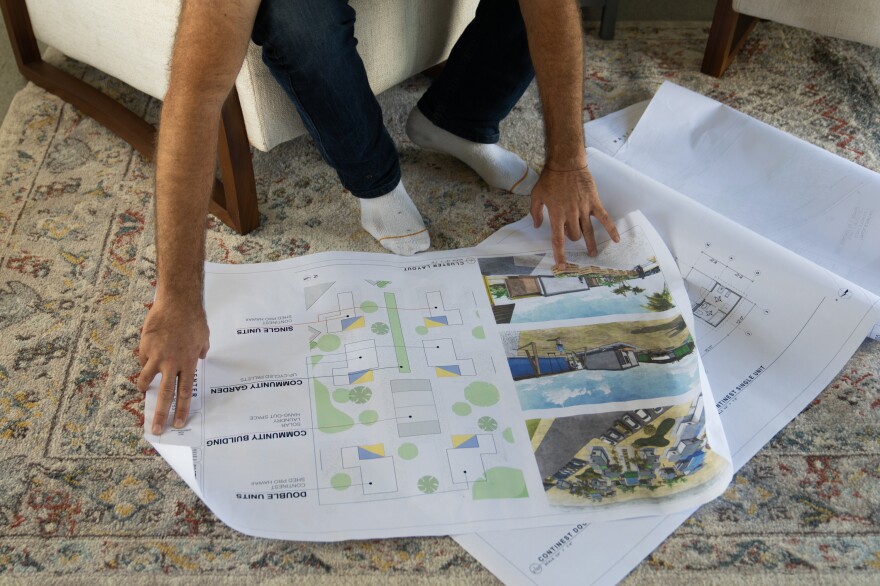MAUI, Hawaii — Natural disasters create a desperate rush to find housing for people who lost their homes. After Maui's wildfires, that effort got an unusual boost — from a massive military jet that delivered pop-up homes.
Now the modular units are transforming a grassy 10-acre field into 85 homes, with housing for around 250 people, according to the Family Life Center, a social service group working to create the Ohana Hope Village.
The first temporary housing modules arrived less than two weeks after fires hit Lahaina and other areas, said David Sellers, the principal architect of Hawaii Off-Grid Architecture and Engineering, a leader in the project.
"I got a picture of them loading on a C-17 and I said, 'Oh wow, this is real. Yeah, let's hurry up.' And we worked through the night and through the weekend and came up with this plan," he said.
The pop-up project quickly went from idea to reality

The tragedy in Lahaina was shockingly sudden, taking just a few hours to erase centuries of history and displace thousands of people. But the community's response was immediate, as people worked together to provide housing and essential items to fire survivors.
"Everything that's happening here is is pretty much unprecedented," Sellers said, citing the support he's seen from individuals, business leaders, and state and local officials.
"Everyone's looking for solutions as quick as possible," he added. "I've never seen anything like it. It's incredible."
The Family Life Center started exploring housing alternatives the day after the fire, according to its CEO, Maude Cumming, who says the organization had already been working with families and elderly people who were affected by the fire.
"We decided everyone needs to have private and easily accessible bathrooms and kitchens," Cumming said. "We began aggressively planning an approach for rapid assembly single-family style shelters."
The modular units come prewired, with doors and windows

The rectangular buildings have a footprint like a shipping container.
"The only difference is, instead of having one 20-foot shipping container, you can have six or seven of these stacked up," Sellers said.
Once the walls are popped up, the biggest task is to link the units to utilities. They come prewired, and they're already insulated — a crucial detail in Hawaii's heat.
"The doors and windows are really nice," Sellers said.
The structures are also quick to set up: the week NPR visited, a crew erected one unit in just 45 seconds.
The project still has a ways to go, but the interest is tangible: "We have already received 145 applications online," Ashley Kelly, Family Life Center's chief operating officer, told NPR.
"We have enough Continest units on island to build 10 homes" right now, Kelly said. "Those should be done by the end of next week or so."
One module can be used on its own, or joined to create twice the living space. The first phase of the plan calls for 60 modules — eight single units, and 26 double units, to cater to families. The master plan includes a playground and communal gathering spaces.
Now, about that C-17

The first batch of pop-up buildings arrived from halfway around the world, where they had originally been earmarked to house people displaced by the war in Ukraine.
The massive cooperative involved diplomats and multiple Family Life Center, and Continest officials, according to Yan Pronin, CEO of Continest's U.S. division. In other humanitarian projects, Pronin says, his company has worked with the World Health Organization to deliver mobile hospitals, and to send housing to refugee camps in Ukraine, his home country.
When the Family Life Center got in touch, Pronin said, his sector of the company had no units to offer — but another division, in Hungary, had some units available. Getting them to Maui took what Pronin calls a "small miracle."
Hungary tapped the international and NATO-based Heavy Airlift Wing to send the housing modules to Hawaii aboard a C-17 cargo jet, using up 80% of the country's allotted annual flying time in the organization, according to Pronin.
For Pronin, the work in Maui matches his own sense of mission. "I'm a fire survivor myself," he says. "I was pulled out of a burning building in a very young age, and the building literally collapsed behind me."
More modules are on the way. If they come by sea, they would arrive in early October. But if they come by air, they could arrive in Maui by the end of September.
Plans like the pop-up village are just one way thousands of people might soon be able to leave hotels and find more permanent housing, during the yearslong effort to build new homes to replace the staggering losses.
Copyright 2023 NPR. To see more, visit https://www.npr.org.



